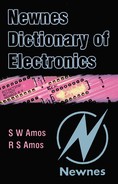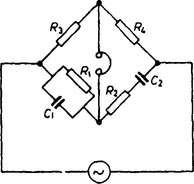W
wafer (1) A thin layer of insulating material carrying switch contacts. Complex switches often consist of several wafers operated by a common control. (2) A thin slice of semiconductor material which, after treatment, becomes a multiplicity of planar transistors or of integrated circuits.
wafer loudspeaker (1) A moving-coil loudspeaker with very little depth designed for use in portable receivers or cars. The small depth is achieved by mounting the magnet within the conical diaphragm. (2) A piezo-electric tweeter with very little depth.
walkie-talkie A colloquial term for a portable transceiver.
water cooling Of a high-power electron tube a method of removing heat by pumping water through a jacket or tubing in direct contact with the external anode or collector, the water giving up the acquired heat in an air-cooled heat exchanger outside the equipment.
Watt The unit of electrical power, symbol W or VA. Practical power values in electronics range from many kilowatts (kW or kVA) through milliwatts (mW) to microwatts (μW).
wave A disturbance propagated through a medium or through space. The disturbance can be, for example, the longitudinal mechanical displacement of a material medium constituting a sound wave or the variations in the transverse magnetic and electric fields constituting a radio wave. The graphical representation of such a disturbance is also termed a wave.
wave analyser Same as harmonic analyser.
waveband A frequency range in the electromagnetic spectrum allocated to a specific radio service. For example the range 525 kHz to 1.6 MHz approximately, known as the medium waveband, is devoted to amplitude-modulated broadcasting.
waveform The shape obtained by plotting the instantaneous amplitude of a varying quantity against time in rectangular coordinates. The waveform of a signal can also be displayed on an oscilloscope by applying the signal to the Y plates and a time base to the X plates.
waveguide In general a system of boundaries between materials or media of different refractive index capable of guiding electromagnetic waves. Thus a length of solid dielectric can act as a waveguide, the wave being propagated along it by successive reflections at the walls. The most familiar type of waveguide is, however, the hollow conducting tube, usually of rectangular cross section. There are various modes of propagation within waveguides and the wave may be launched in it or abstracted from it by a probe or a loop projecting into the waveguide. For efficient propagation the cross-sectional dimensions must not be less than half a wavelength and thus to keep the cross section to a reasonable size the frequency of the elctromagnetic waves must be high: it is usually in the microwave region.
wavelength (λ) Of a periodic wave the distance between points of equal phase in consecutive cycles measured at any instant in the direction of propagation of the wave. It is equal to the distance travelled by the wave in one period of oscillation. For electromagnetic waves the wavelength λ is related to the frequency f by the expression
where v is the velocity of propagation. Thus a frequency of 1 MHz corresponds to a wavelength of 300 m, the velocity of propagation being 3 × 108 m/s.
wavemeter Instrument for measuring the wavelength of an electromagnetic wave either directly or, more usually, indirectly by measuring the frequency. See absorption frequency meter.
wavetrap Same as rejector circuit.
weighting The modification of objective measurements for example to obtain better correlation with subjective assessments. As an example audio noise measurements may be made via a frequency-discriminating (weighting) network which allows for the way in which the annoyance value of noise varies with frequency over the audio band.
Weston cadmium cell A standard primary cell with electrodes of mercury (positive) and cadmium-mercury amalgam (negative), electrolyte of cadmium sulphate and depolariser of mercurous sulphate. The EMF is 1.108 V at 20°C and the variation of EMF with temperature is known to a high degree of accuracy. See standard cell.
What You See Is What You Get (WYSIWYG) A term sometimes used to describe computer graphics and DTP applications in which the VDU display accurately (within its capabilities) represents the printed output.
Wheatstone’s bridge A network of four resistors in bridge formation used for the measurement of unknown resistances. The circuit is shown in Figure W.1. If the ratio of R1 to R2 is the same as that of R3 to R4 the PD across R2 is equal to that across R4 and the galvanometer gives zero deflection. At balance the following relationship applies
Thus, if R1, R2 and R3 are known, R4 can be calculated. R1 and R2 are known as the ratio arms.
white compression or white crushing In TV, reduction of the gain at signal levels corresponding to white compared with the gain at black and mid-grey levels. The effect of white compression is to reduce the visibility of detail in highlight areas of the reproduced image.
white level In black-and-white TV the maximum permitted level of the picture signal (or, in colour TV, of the luminance component).
white noise A random noise signal with a level frequency response over a wide frequency range embracing the audible spectrum. Such a noise is used in audio-frequency testing, e.g. of loudspeakers where the noise, which sounds like escaping steam, acquires a coloration if the loudspeaker has resonances. The term is analogous to white light which has components spread over the whole of the visible spectrum.
white peak (US) Same as peak white.
wide area network (WAN) A network of computers on various premises and requiring the use of telecommunications lines to facilitate the exchange of data. Typically WANs connect local area networks rather than individual computers, the connection between the LAN and the telecommunications line being by a device called a bridge (or router).
width control (1) In TV receivers the control which determines the amplitude of horizontal deflection and hence the width of the displayed picture. The control is often a variable inductor connected in series with the line deflection coils. (2) In stereo sound reproduction a control which determines the apparent width of the sound source. It is often a variable resistor bridging the two channels and, in the zero-resistance position, parallels them so that the sound appears to originate from a point source located midway between the two loudspeakers.
Wien bridge An AC bridge circuit in which one arm consists of resistance and capacitance in series, an adjoining arm consists of resistance and capacitance in parallel, the remaining arms being purely resistive. The bridge, shown in Figure W.2, is used for measuring capacitance in terms of resistance and frequency. At balance the following relationships apply:
which give the following expressions for C1 and C2
There is a corresponding Wien inductance bridge.
Wien-bridge oscillator A phase-shift oscillator of which the frequency is determined by the resistance and capacitance values of a Wien-bridge circuit. The network shown in Figure W.3 consists of two equal resistors and two equal capacitors in a Wien-bridge arrangement. This network gives zero phase shift at the frequency for which
and at this frequency
If therefore an amplifier with zero phase shift and a voltage gain of 3 is connected between the output and input terminals of the network oscillation will result. This is the basis of a number of AF test oscillators. The amplifier gain is stabilised at 3 by negative feedback which can also serve to keep the output level constant. The frequency can be varied by using a two-gang variable capacitor for C, R being adjusted in steps to give different frequency ranges.
Winchester disk One sort of hard disk. See hard disk.
window An area in a VDU display dedicated to one application. In a multitasking computer system, several windows may be present simultaneously, which may belong to more than one application. Only one window at a time may be active (it is said to have the input focus) and this window will be at the front of the display, hiding areas of other windows which it overlaps.
Windows™ The Microsoft Windows operating environment which provides a user-friendly multitasking interface with MS-DOS and compatible operating systems.
wire broadcasting The distribution of sound and/or TV programmes to a number of receivers over a wired distribution system using audio frequencies or modulated carrier frequencies.
wired AND Same as distributed connection.
wired OR Same as distributed connection.
wobbulator An RF signal generator the instantaneous frequency of which can be varied continuously in a known periodic manner over a known fixed or adjustable range without change in amplitude. It is used in conjunction with an oscilloscope to display the shape of the passband of a receiver to facilitate alignment of the tuned circuits.
woofer A loudspeaker unit designed to radiate audio frequencies below approximately 200 Hz. Woofers are usually moving-coil units and are used in conjunction with other units and crossover networks in high-quality wide-range loudspeakers.
word processor A system for writing, editing, printing and storage of documents. Most word processors are general-purpose microcomputers or minicomputers executing word-processing programs. Text typed at the keyboard appears on the screen of a VDU and is also stored in memory. Software routines allow such facilities as the insertion and deletion of matter, the movement of blocks of text, searches for the occurrence of a particular string of characters (with the option of replacing it by an alternative string) and word counts. A hard copy of the document may be produced on a printer, formatting routines permitting such features as the centring of titles and justification (straightening) of the right-hand margin.
work function The energy required to emit a single electron from a cathode into a field-free space. Its value depends on the material of the cathode.
working point Same as operating point.
working storage Same as temporary storage.
workstation A vague term used in various ways to indicate the data processing or communications equipment needed by one employee at his or her desk. In computing the term is sometimes reserved for specialised high-speed hardware for complex graphics work such as CAD, but the term programmable workstation (PWS) may be applied to any microcomputer being used as an intelligent terminal to access a mainframe computer. In telecommunications the term is sometimes used to refer to a computer and a telephone on the same desk and sharing the same access to the telecommunications network.
worldwide web A network of linked documents residing on the Internet.
WORM (Write Once Read Many times) Any storage system in which data can be written (recorded), but not erased. Consequently the stored data cannot be amended, although an amended version may be stored subsequently elsewhere on the media. The best known WORM system is CD-recordable which stores data on Compact Disc. This is used for backing up hard drives and archiving records of various kinds.
wow Distortion in sound reproduced from disk, film or tape and caused by undesired rhythmic speed variations on recording or reproduction. It is usually caused by eccentric or unbalanced driving of the film, tape or turntable. The variations occur at a rate of less than 20 Hz and cause unpleasant variations in pitch which are particularly noticeable in the reproduction of the piano and of sustained notes.
wrapped connection A method of securing low-resistance contact between a wire and a post by wrapping the wire around a sharp-cornered post under controlled tension using a hand- or power-operated tool. Wrapped connections have been used for twenty-five years and have proved a satisfactory alternative to the soldered connection.
writing In computers and data-processing equipment the process of recording information in a storage device or on a data medium. See reading.
writing speed Of a cathode ray tube the maximum speed at which the spot can travel on the screen whilst still maintaining a required degree of resolution. The more rapidly the spot moves the fainter is the trace generated. Thus there is an upper limit to the speed which can usefully be employed.




